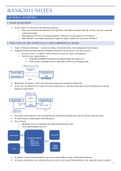Class notes
BANK3011 Bank Financial Management Notes
- Course
- Institution
- Book
Notes cover content for entire semester Topics covered: * Introduction and overview of the financial system and the role of Banks * Interest rate risk: measurement * Market risk: measurement and the application of Value at Risk * Credit risk: individual loan risk measurement * Credit risk: ...
[Show more]




